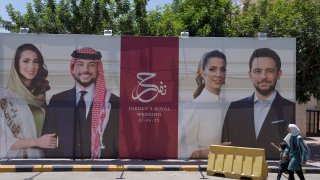
Jordan's highly anticipated royal wedding day got underway on Thursday with the surprise announcement that Britain's Prince William and his wife Kate had arrived to witness the nuptials of Crown Prince Hussein and his Saudi Arabian bride.
The attendance of the British royals had been kept under wraps, and was only confirmed by Jordanian state media a few hours before the start of the palace ceremony.
The wedding of Jordan's 28-year-old heir to the throne and Rajwa Alseif, a 29-year-old architect linked to her own country's monarch, emphasizes continuity in an Arab state prized for its longstanding stability. The festivities, which are to start Thursday afternoon, also introduce Hussein to a wider global audience.
The celebration buttresses the royal family's order of succession, refreshes its image after a palace feud and may even help resource-poor Jordan forge a strategic bond with its oil-rich neighbor, Saudi Arabia.
Get top local stories in Philly delivered to you every morning. Sign up for NBC Philadelphia's News Headlines newsletter.
On Thursday morning, Saudi wedding guests and tourists — the men wearing white dishdasha robes and the women in brightly colored abayas — filtered through the sleek marbled lobby of the Four Seasons Hotel in Amman. Noura Al Sudairi, an aunt of the bride, was wearing sweatpants and sneakers on her way to breakfast.
“We are all so excited, so happy about this union,” she said. “Of course it’s a beautiful thing for our families, and for the relationship between Jordan and Saudi Arabia.”
Excitement over the nuptials — Jordan’s biggest royal event in years — has been building in the capital of Amman, where congratulatory banners of Hussein and his beaming bride adorn buses and hang over winding hillside streets. Shops had competing displays of royal regalia. Royal watchers speculated about which dress designer Alseif would select— still an official secret,
U.S. & World
Stories that affect your life across the U.S. and around the world.
Nancy Tirana, a 28-year-old law intern, said she spent the last week scrutinizing Alseif’s every move and stitch of clothing.
“She’s just so beautiful, so elegant, and it’s clear from her body language how much she loves the queen,” she said, referring to Hussein's glamorous mother, Rania. “I feel like all of Jordan is getting married," Tirana gushed as she ate mansaf, Jordan’s national dish of milky mutton and rice, before heading to a wedding-themed concert.
Jordan’s 11 million citizens have watched the young crown prince rise in prominence in recent years, as he increasingly joined his father, King Abdullah II, in public appearances. Hussein has graduated from Georgetown University, joined the military and gained some global recognition speaking at the U.N. General Assembly. His wedding, experts say, marks his next crucial rite of passage.
“It’s not just a marriage, it’s the presentation of the future king of Jordan,” said political analyst Amer Sabaileh. “The issue of the crown prince has been closed.”
The wedding may create a brief feel-good moment for Jordanians during tough economic times, including persistent youth unemployment and an ailing economy.
Palace officials have turned the event — a week after Jordan’s 77th birthday — into something of a PR campaign. Combining tradition and modernity, the royal family introduced a wedding hashtag (#Celebrating Al Hussein) and omnipresent logo that fuses the couple’s initials into the Arabic words “We rejoice”
Photos and reels from Alseif’s henna party — a traditional pre-wedding celebration featuring the bride and her female friends and relatives — and the couple’s engagement ceremony in Saudi Arabia last summer have splashed across state-linked media.
The kingdom declared Thursday a public holiday so crowds of people could gather after the wedding service to wave at the couple’s motorcade of red Land Rover jeeps — a nod to the traditional procession of horse riders clad in red coats during the reign of the country’s founder, King Abdullah I. Tens of thousands of well-wishers are expected to flock to free concerts and cultural events. Huge screens have been set up nationwide for crowds to watch the occasion unfold.
The signing of the marriage contract will take place at Zahran Palace in Amman, which hasn’t seen such pomp and circumstance since 1993, when, on a similarly sunny June day, Abdullah married Rania, who was born in Kuwait to Palestinian parents. Decades earlier, Abdullah's father, the late King Hussein, sealed his vows in the same garden with his second wife, the British citizen Antoinette Gardiner.
In addition to the Prince and Princess of Wales, the guest list includes an array of foreign aristocrats and dignitaries, including senior royals from Europe and Asia, as well as First Lady Jill Biden and U.S. climate envoy John Kerry. Other likely attendees include Saudi aristocrats, as Alseif’s mother traces her roots to the influential wife of Saudi Arabia’s founder, King Abdul-Aziz Al Saud, Her billionaire father owns a major construction firm in the kingdom.
After the ceremony, the wedding party will move to Al Husseiniya Palace, a 30-minute drive away, for a reception, entertainment and a state banquet. The royals are expected to greet more than 1,700 guests at the reception.
Experts consider the marriage an advantageous alliance for the Hashemites, historic rivals of the Al Saud family to the east. Jordan has recently sought closer ties with Saudi Arabia and other Gulf Arab petrostates, which once doled out billions of dollars to the aid-dependent country but since have reined in their spending.
Even as restaurants blared call-and-response Arabic wedding songs and cars honked in celebration downtown, some signaled the royal fairy tale was fraught as Jordanians struggle to make ends meet.
Osama, a 25-year-old bookseller, was thrilled about the occasion and festooned his car and shop windows with portraits of the royal family. But he also knew reality would return quickly.
“Of course, it’s joyful,” he said, declining to give his last name for fear of reprisals. “But in a couple days, we’ll just go back to our problems.”



